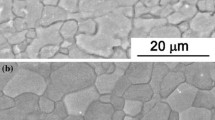Abstract
The flow and fracture strengths of polycrystalline aggregates of high purity magnesium and a solid solution of aluminum in magnesium were determined as functions of temperature and grain size. Magnesium was found to obey two distinct fracture laws. Over the high temperature range, the fracture stress decreased with increasing test temperatures in a manner that closely paralleled the flow stress-temperature relationship. However, over the low temperature range, the fracture stress was independent of the test temperature though highly dependent on grain size, following the trend that is typical for the low temperature brittle fracturing of polycrystalline aggregates of body-centered-cubic and close-packed-hexagonal metals. Even at 78°K, however, plastic strains of 1 to 7 pet were obtained preceding onset of brittle fracturing. Over the brittle fracture range of temperatures, the fracture stress increased linearly with the reciprocal of the square root of the mean grain diameter, while over the entire range of temperatures investigated, the flow strength was observed to increase linearly with the reciprocal of the square root of the mean grain diameter.
Similar content being viewed by others
References
F. E. Hauser, C. D. Starr, L. S. Tietz, and J. E. Dorn: Deformation Mechanism in Polycrystalline Aggregates of Magnesium. Trans. ASM (1955) 47, p. 102.
F. E. Hauser, P. R. Landon, and J. E. Dorn: Deformation and Fracture Mechanisms of Polycrystalline Magnesium at Low Temperature. Research Report Inst, of Engineering, Univ. of California (1954) Series No. 73, Issue No. 3.
A. A. Griffith: The Theory of Rupture. Philosophical Transactions Royal Soc, London (1920) 221A, p. 163.
E. Orowan: Fundamentals of Brittle Behavior in Metals. Fatigue and Fracture of Metals. (1952) p. 139. Ed. by W. M. Murray. New York. John Wiley & Sons.
C. Zener: Fracture of Metals. Trans. ASM (1948) 40A, p. 3.
J. S. Koehler: Physical Review (1952) 85, p. 480.
J. E. Eshelby, F. C. Frank, and F. R. N. Nabarro: Philosophical Magazine (1951) 42, p. 351.
N. J. Petch: The Fracture of Metals. Progress in Metal Physics (1954) 5, p. 1.
G. W. Greenwood and A. G. Quarrell: The Cleavage Fracture of Pure Polycrystalline Zinc in Tension. Journal Inst, of Metals (1953-1954) 82, p. 551.
A. N. Stroh: The Formation of Cracks as a Result of Plastic Flow. Proceedings Royal Soc, London (1954) 223, p. 404.
Author information
Authors and Affiliations
Additional information
TP 4191E. Manuscript, May 6, 1955. New York Meeting, February 1956.
Rights and permissions
About this article
Cite this article
Hauser, F.E., London, P.R. & Dorn, J.E. Fracture of Magnesium Alloys at Low Temperature. JOM 8, 589–592 (1956). https://doi.org/10.1007/BF03377735
Published:
Issue Date:
DOI: https://doi.org/10.1007/BF03377735




